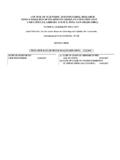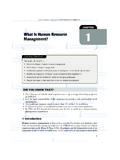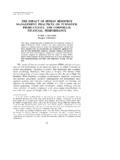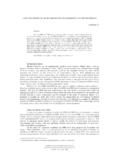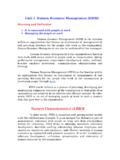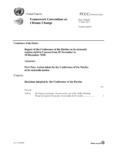Transcription of DEVELOPING GLOBAL HUMAN RESOURCE …
1 DEVELOPING GLOBAL HUMAN RESOURCE strategies Hans-Erich Mueller FHW-Berlin School of Economics Discussion paper for European International Business Academy 27th Annual Meeting, 13-15 December 2001 in Paris Abstract. A few years ago it was typical to give one s subsidiaries a free rein and send managers overseas from headquarters only. But today a great deal depends on overcoming this one-way street and in looking for and employing the best-suited managers, regardless of their origins. What contribution can HUMAN RESOURCE management make towards a company s GLOBAL orientation an area in which local scope and latitude are traditionally very high? Our study shows that in recent years large US and German industrial enterprises have re-aligned the management of their executive staff.
2 Cornerstones of this quiet revolution are a policy of worldwide parity of executives in evaluation, remuneration and development, greater participation of those with line responsibility from product areas and regions in strategic development, as well as a re-alignment of HUMAN RESOURCE instruments. Worldwide standards in HUMAN RESOURCE policy are key factors in the competition for qualified managers. Not only companies, but also executives need to adjust. How have these companies managed to press ahead this quantum leap in their international strategy for executives? What significance do local or cultural differences have, if any? What are the possible consequences of this job market opening? The following article makes best practice proposals for pursuing new avenues towards a cross-border HUMAN RESOURCE strategy.
3 Hans-Erich Mueller is a Professor of Management and Organization at the FHW-Berlin School of Economics in Berlin/Germany and a guest professor at Reims Management School in France. Parts of this article are published in German as Wie GLOBAL Player den Kampf um Talente f hren in Harvard Business Manager 2001, No. 6, p. 16-25 HANS-ERICH MUELLER DEVELOPING GLOBAL HUMAN RESOURCE strategies - 2 - Cynics ask: What s so important about globalization? It s been under way for decades. In fact, in the beginning it only affected a few areas and only a few functions like marketing and financing. GLOBAL Players were certainly exceptions to the rule. In the meantime however, this process has gained in breadth and latitude: today it no longer depends on if but rather on how on Best Practices in International Business (Czinkota/Ronkainen 2001).
4 In the near future and in almost every area of business, we will be forced to contend with the challenges of a GLOBAL economy, in which the old rules no longer apply and the new ones are yet to be developed. And this also applies to the area often considered the tailender: cross-border HUMAN RESOURCE management. Do you have worldwide HR policies, that is, policies that apply to all employees regardless of location? This is one of the central questions underlying our interviews with HRM executives of the twelve largest German manufacturers, which took place between the summer and fall of 2000. This includes the largest German companies excluding trade, banking and insurance, as well as energy suppliers according to the Business Week GLOBAL 1000, 12 July 1999.
5 We wanted to measure the degree of development in an area in which, traditionally, decision-making had rarely been centralized and questions concerning the overseas assignments dominated. In other words, is HUMAN RESOURCE management also in the process of being globally integrated as other functions previously? Is there enough room for adequate local adjustment? How and with whom will this changed policy be developed and implemented? The idea for our study originated from our collaboration with Thomas M. Begley and David P. Boyd of Northeastern University in Boston, who interviewed executives from 32 large based high technology companies, such as AT&T, Cisco, IBM, Intel and Microsoft in the same way. It is interesting to compare our results. SENIOR MANAGEMENT STRATEGY HAS CHANGED: GLOBAL INTEGRATION The same worldwide standards for senior management in evaluation, compensation and development are the milestones en route towards a GLOBAL HUMAN RESOURCE strategy, which has only caught on in recent years at German companies like BASF, Bayer, DaimlerChrysler, Henkel, Lufthansa, SAP, Schering, Siemens, and Volkswagen.
6 HANS-ERICH MUELLER DEVELOPING GLOBAL HUMAN RESOURCE strategies - 3 - Roland Schulz, Personally Liable Associate at Henkel, describes this change in strategy for his company : Up until 1990 we were very German-oriented , allowing the subsidiaries in individual countries a great deal of autonomy. Only for the top two hundred executives was there something like an alignment or standardization of a few specific themes. But for the past ten years we have been actively redrafting all of our HUMAN RESOURCE policy instruments systematically, and we think in a professional way. So, today, we are able to say that we have succeeded in creating a comprehensive executive structure, allowing us to treat key questions of HUMAN RESOURCE policy in a unified way. Evaluation, compensation, management development, training and education we have harmonized all of these instruments for executives and made them binding worldwide.
7 Henkel sees itself as a leader in HUMAN RESOURCE policy, both within and beyond its own areas of business, one which brings about more equality of treatment and fairness, so that qualified executives can commit themselves to the company and participate in its success. Reviewing international HUMAN RESOURCE strategy. Not every company needs to follow these examples exactly. It is clear that there is not just one right course of action for HUMAN RESOURCE as well as company strategy. There are four principle alternatives between local adaptation ( responsiveness ) and GLOBAL integration with respective coordination costs (see box 1 below). Four alternatives for a cross border strategy Local Adaptation: International Strategy: appropriate when there is little foreign business knowledge transfer from the center of headquarters.
8 Coordination cost are low. Multinational Strategy: Affiliates are autonomous and local adapted. Cross-border-advantages of standardization and learning are low. Coordination-costs are lowest. Globale Integration: GLOBAL Strategy: Advantages of standardization of policies and practices. Strong centralism. Lack of local responsiveness causes disadvantages. National segmented markets, cultures, policies set barriers. Coordination costs are high. HANS-ERICH MUELLER DEVELOPING GLOBAL HUMAN RESOURCE strategies - 4 - Transnational Strategy: uses advantages form globalization, localization and cross-border-learning simultaneously. Coordination cost are highest. (see Bartlett /Goshal 1998) None of these large German manufacturers we interviewed pursues a comprehensive, all-inclusive, globally integrated HUMAN RESOURCE policy.
9 The autonomy of the national companies in terms of the HUMAN RESOURCE policy for commercial staff is not noticeably limited, whereas corporate normally assumes exclusive responsibility for decisions concerning executives (Macharzina/ Wolf 1998). But even in this executive area not every company has completed its change of strategy towards GLOBAL integration. Deutsche Telekom and Preussag (the former steel manufacturer-turned tourism giant), who have recently become more international in their orientation, are just now in the process of preparing themselves for a cross-border, integrated HUMAN RESOURCE policy. The autonomy of the newly purchased overseas companies has been substantial so far. Bertelsmann, where deployment has traditionally been decentralized, has just begun a more integrated policy for senior management.
10 Lufthansa in the Star Alliance network, too, participated recently for the first time in creating a sound foundation for a GLOBAL executive management scheme. Moving towards GLOBAL integration. Every company will have to find its own route and this will depend on the situation and will be different for executive management and specialized staff. The decisive turnaround within today s HUMAN RESOURCE policy appears to be in the replacement of both local autonomy and the home country preference: companies successful across borders with corporate headquarters in Germany have pursued a more globally integrated HUMAN RESOURCE strategy. Begley/Boyd (2001) also found a globally-oriented executive policy amongst the 32 American high tech companies. In another study, Conn/Yip examined 35 large American multinationals and documented the advantages of such a strategy statistically.

